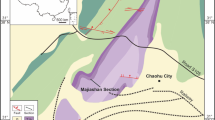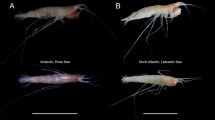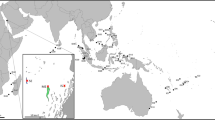Abstract
The deep ocean is home to a group of broad-collared hemichordates—the so-called ‘lophenteropneusts’—that have been photographed gliding on the sea floor1,2,3,4,5,6,7,8 but have not previously been collected. It has been claimed that these worms have collar tentacles and blend morphological features of the two main hemichordate body plans, namely the tentacle-less enteropneusts and the tentacle-bearing pterobranchs. Consequently, lophenteropneusts have been invoked as missing links to suggest that the former evolved into the latter5. The most significant aspect of the lophenteropneust hypothesis is its prediction that the fundamental body plan within a basal phylum of deuterostomes was enteropneust-like. The assumption of such an ancestral state influences ideas about the evolution of the vertebrates from the invertebrates9,10,11,12,13,14. Here we report on the first collected specimen of a broad-collared, deep-sea enteropneust and describe it as a new family, genus and species. The collar, although disproportionately broad, lacks tentacles. In addition, we find no evidence of tentacles in the available deep-sea photographs (published and unpublished) of broad-collared enteropneusts, including those formerly designated as lophenteropneusts. Thus, the lophenteropneust hypothesis was based on misinterpretation of deep-sea photographs of low quality and should no longer be used to support the idea that the enteropneust body plan is basal within the phylum Hemichordata.
This is a preview of subscription content, access via your institution
Access options
Subscribe to this journal
Receive 51 print issues and online access
$199.00 per year
only $3.90 per issue
Buy this article
- Purchase on Springer Link
- Instant access to full article PDF
Prices may be subject to local taxes which are calculated during checkout



Similar content being viewed by others
References
Bourne, D. W. & Heezen, B. C. A wandering enteropneust from the abyssal Pacific, and the distribution of ‘spiral’ tracks on the sea floor. Science 150, 60–63 (1965)
Ewing, M. & Davis, R. A. in Deep Sea Photography (ed. Hersey, J. B.) 259–294 (Johns Hopkins Press, Baltimore, Maryland, 1967)
Jacobs, S. S., Bruchhausen, P. M. & Bauer, E. B. Hydrographic Stations, Bottom Photographs, Current Measurements, and Nephelometer Profiles. Eltanin Reports, Cruises 32–36 (Lamont-Doherty Geological Observatory, Palisades, New York, 1970)
Heezen, B. C. & Hollister, C. D. The Face of the Deep (Oxford Univ. Press, New York, 1971)
Lemche, H., Hansen, B., Madsen, F. J., Tendal, O. S. & Wolff, T. Hadal life as analyzed from photographs. Vidensk. Meddr. Dansk Naturh. Foren. 139, 262–336 (1976)
Thiel, H. Structural aspects of the deep-sea benthos. AMBIO Spec. Rep. 6, 25–31 (1979)
Foell, E. J. & Pawson, D. L. Photographs of invertebrate megafauna from abyssal depths of the north-eastern equatorial Pacific Ocean. Ohio J. Sci. 86, 61–68 (1986)
Gaillard, C. Recent organism traces and ichnofacies on the deep-sea floor off New Caledonia, southwestern Pacific. Palaios 6, 302–315 (1991)
Bateson, W. The ancestry of the Chordata. Q. J. Microsc. Sci. 26, 535–571 (1886)
Jollie, M. The origin of chordates. Acta Zool. Stockh. 54, 81–100 (1973)
Dilly, P. N. The pterobranch Rhabdopleura compacta: its nervous system and phylogenetic position. Symp. Zool. Soc. Lond. 36, 1–16 (1975)
Jefferies, R. P. S. in Major Events in Early Vertebrate Evolution (ed. Ahlberg, P. E.) 40–66 (Taylor & Francis, London, 2001)
Lowe, C. J. et al. Anteroposterior patterning in hemichordates and the origin of the chordate nervous system. Cell 113, 853–865 (2003)
Cameron, C. B., Garey, J. R. & Swalla, B. J. Evolution of the chordate body plan: new insights from phylogenetic analysis of deuterostome phyla. Proc. Natl Acad. Sci. USA 97, 4469–4474 (2000)
Woodwick, K. H. in Taxonomic Atlas of the Benthic Fauna of the Santa Maria Basin and the Western Santa Barbara Channel Vol. 14 (eds Blake, J. A., Scott, P. H. & Lissner, A.) 251–259 (Santa Barbara Museum of Natural History, Santa Barbara, 1993)
Woodwick, K. H. & Sensenbaugh, T. Saxipendium coronatum, new genus, new species (Hemichordata: Enteropneusta): the unusual spaghetti worms of the Galápagos Rift hydrothermal vents. Proc. Biol. Soc. Wash. 98, 351–365 (1985)
Young, C. M. in Ecosystems of the Deep Oceans (ed. Tyler, P. A.) 381–426 (Elsevier, Amsterdam, 2003)
Pawson, D. Deep-sea dreams: diary of a mad lophenteropneust watcher. Deep-Sea Newsl. 32, 6–7 (2003)
Tendal, O. S. What became of Lemche's lophenteropneust? Deep-Sea Newsl. 27, 21–24 (1998)
Tendal, O. S. Lemche's lophenteropneust widely known but still an enigma. Deep-Sea Newsl. 28, 8 (1999)
Gage, J. D. & Tyler, P. A. Deep Sea Biology, a Natural History of Organisms at the Deep-Ocean Floor (Cambridge Univ. Press, Cambridge, 1991)
Spengel, J. W. Fauna und Flora des Golfes von Neapel Monograph 18, Die Enteropneusten des Golfes von Neapel (Friedländer, Berlin, 1893)
Menzies, R. J., George, R. Y. & Rowe, G. T. Abyssal Environment and Ecology of the World Oceans (Wiley, New York, 1973)
Thorndike, E. M., Gerard, R. D., Sullivan, L. G. & Paul, A. Z. in The Ocean Floor (eds Scrutton, R. A. & Talwani, M.) 255–275 (Wiley, Chichester, 1982)
Bett, B. J. UK Atlantic margin environmental survey: introduction and overview of bathyal benthic ecology. Cont. Shelf Res. 21, 917–956 (2001)
Acknowledgements
We thank C. B. Cameron and R. P. S. Jefferies for valuable taxonomic advice, and B. J. Bett, J. Barry, R. Logeman, B. H. Robison, R. J. Singleton, R. C. Vrijenhoek and the crews and pilots of the research vessels Western Flyer, Akedemik Mstislav Keldysh and G.O. Sars, the manned submersibles ‘Mir1’ and ‘Mir2’, and the ROVs ‘Tiburon’ and ‘Bathysaurus’ for animal collection, photography, and unpublished observations. This study was partly under the auspices of the MAR-ECO Project within the Census of Marine Life Program and was partly supported by the New Zealand Foundation for Research, Science and Technology.
Author information
Authors and Affiliations
Corresponding author
Ethics declarations
Competing interests
The authors declare that they have no competing financial interests.
Rights and permissions
About this article
Cite this article
Holland, N., Clague, D., Gordon, D. et al. ‘Lophenteropneust’ hypothesis refuted by collection and photos of new deep-sea hemichordates. Nature 434, 374–376 (2005). https://doi.org/10.1038/nature03382
Received:
Accepted:
Issue Date:
DOI: https://doi.org/10.1038/nature03382
This article is cited by
-
The phylogeny, evolutionary developmental biology, and paleobiology of the Deuterostomia: 25 years of new techniques, new discoveries, and new ideas
Organisms Diversity & Evolution (2016)
-
Modern Antarctic acorn worms form tubes
Nature Communications (2013)
-
Mystery tubes coiled around deep-water tropical gorgonians: fecampiid cocoons (Platyhelminthes: Fecampiida) resembling Solenogastres (Mollusca)
Systematic Parasitology (2007)
-
Deep-sea spiral fantasies
Nature (2005)
Comments
By submitting a comment you agree to abide by our Terms and Community Guidelines. If you find something abusive or that does not comply with our terms or guidelines please flag it as inappropriate.



